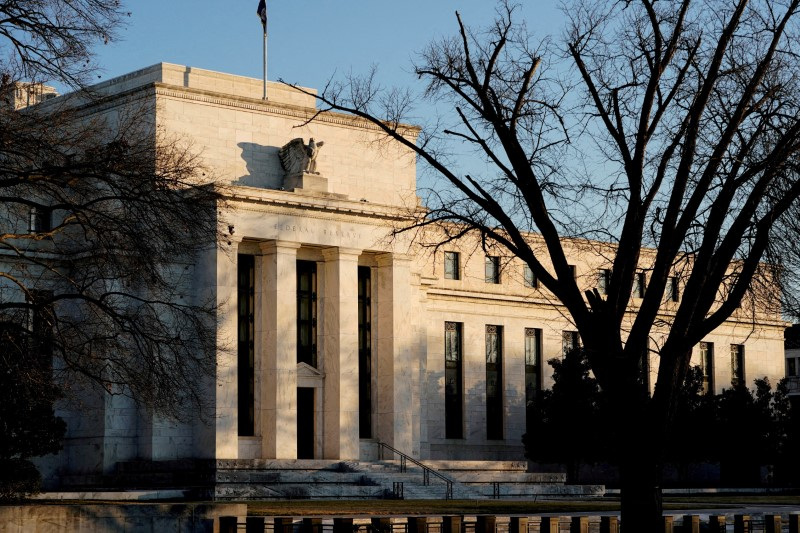Fed lifts neutral view; more to come?: McGeever

FILE PHOTO: The Federal Reserve building in Washington, U.S., January 26, 2022. REUTERS/Joshua Roberts/File Photo
ALVG
+0.96%
Add to/Remove from Watchlist
Add to Watchlist
Add Position
Position added successfully to:
Please name your holdings portfolio
Type:
BUY
SELL
Date:
Amount:
Price
Point Value:
Leverage:
1:1
1:10
1:25
1:50
1:100
1:200
1:400
1:500
1:1000
Commission:
Create New Watchlist
Create
Create a new holdings portfolio
Add
Create
+ Add another position
Close
By Jamie McGeever
ORLANDO, Florida (Reuters) -Fed policymakers on Wednesday kept their 2024 U.S. interest rate projection unchanged, but the floor for rates once cuts start is moving higher.
In their quarterly Summary of Economic Projections, officials raised the median outlook for 2025 and 2026, and more importantly, increased their longer-run median interest rate outlook above 2.5% for the first time in five years.
The median 2025 and 2026 rate views were raised by three tenths of one percent to 2.9% and 3.1%, respectively, and the longer-run rate was lifted by one tenth of a percentage point to 2.6%.
As the Fed maintained its long-run inflation projection at its 2% target, this implies a slight increase in what policymakers deem to be the neutral real rate of interest, or ‘R-star’, to 0.6% from 0.5%.
These were small changes, particularly to the longer run projection, but they could be significant.
Collectively, they show the Fed recognizes that policy needs to be tighter for longer in the post-pandemic world to get inflation back down to target and keep it there. Seven Fed officials now see a neutral rate of 2.9% or higher, compared with four in December.
Another way of looking at it, with growth consistently surprising on the upside, the post-pandemic U.S. economy is much less responsive to interest rate hikes than it was before March 2020.
These are hardly new revelations – rates futures markets have for some time priced in a higher terminal rate than that implied in the SEP projections – but the highest neutral rate outlook since 2018 is a marker.
The question now is whether that gap between the market-based and Fed view for the terminal rate, the policy rate once the easing cycle ends, begins to converge.
“We’re on a higher glide path,” said Gregory Daco, chief economist at EY. “There’s a more consistent view between the market and the Fed on ending the easing cycle at a level that is higher than what had been consistent with previous cycles.”
BABY STEPS
Fed Chair Jerome Powell downplayed the new neutral rate projection, calling the move “modest” and noting that the long-term horizon is shrouded in huge uncertainty.
In addition structural factors like demographics, productivity trends and cross-border capital flows help determine ‘R-star’, and the pace of change in these can be glacial.
But Powell did say his “instinct” is that interest rates will not return to pre-pandemic low levels.
Again, this is not a particularly revelatory position but it does chime with what the bond and rates markets have been signaling recently.
Breakeven inflation rates on 10- and 30-year inflation-linked Treasury bonds are hovering around 2.3% and drifting closer to 2.5%, a sign that bond traders are not fully convinced the Fed will get inflation back down to target.
Interest rate futures currently imply a terminal rate of 3.7% by the end of 2026, a good bit higher than the Fed’s projected 3.1% over the same time horizon, never mind the long-run neutral view of 2.6%.
With growth running hotter than nearly all forecasts and inflation proving stickier than Fed officials would like, it’s more likely that any convergence will see the Fed’s rate view drift towards the market’s rather than the other way around.
“There is still a clear difference between the market and the Fed in terms of where the terminal rate will land,” says Charlie Ripley, senior investment strategist at Allianz (ETR:ALVG) Investment Management.
“The main implication (of this) is that a policy rate set lower than the natural rate for a longer period of time could bring on unintended price instability or unwanted inflation.”
The first step to closing that gap was taken on Wednesday. It may not be the last.
(The opinions expressed here are those of the author, a columnist for Reuters.)
(By Jamie McGeeverEditing by Shri Navaratnam)








